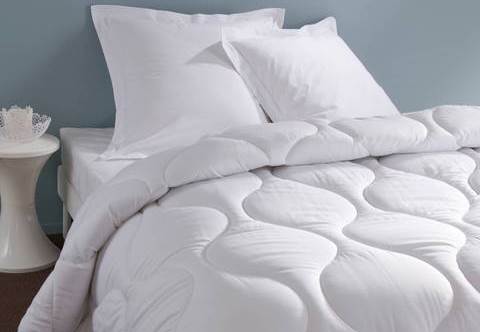Your guide to shopping
- Details
- PRACTICAL PRACTICAL
- ➤ SHOPPING HOW-TO SHOPPING HOW-TO
- Published: 16 December 2015 16 December 2015
The mattress and sheets are paramount to ensuring that your travellers have a restful sleep, but the comforter also has a crucial role to play. This guide will help you decide which duvet suits you best…
Choosing the Right Dimensions
Comforters sizes run slightly larger than mattress sizes to allow for draping over the sides of the bed. Their size corresponds with bed sizes (twin, double, queen, king...), which vary around the world, with countries having their own standards and terminology. You can learn more on bed sizes via these two articles on Wikipedia and on The Sleep Judge.
Typical sizes in the United States for comforters are: for a twin 64 in × 87 in, for a queen 87 in × 87 in and for a king 101 in × 90 in.
In Continental Europe, until recently, the standard two-person bedding dimensions were 54 in x 75 in. For this type of bed, the proper duvet to get is 87 in x 94 in. More and more, however, most european countries are gravitating towards 63 in x 79 in mattresses, and in that case the best duvet is 94 in x 102 in. For beds with a width of 71 in, it’s best to opt for two duvets of 55 in x 79 in when the bed is shared.
Sizes for other countries.
Choosing the Right Density
Density refers to the weight of your comforter filling, and can range from 180 g/m2 for light comforters to 500 g/m2 for winter comforters. As such, the higher the density, the warmer and heavier your comforter will be.
Down comforters: The filling can be quite light. For a summer comforter, opt for a density of 180 g/m2 and for a winter comforter 270 g/m2.
Synthetic comforters: To achieve the same level of insolation, they have to be heavier. When choosing a summer comforter, opt for a density of 200 to 250 g/m2 and for a winter comforter 300 to 450 g/m2.
Generally, we can assume that light comforters are ideal for heat sensitive people and room temperatures above 22°C. Moderate comforters are ideal for room temperatures between 18 and 22°C. Warm and heavy comforters are ideal for cold sensitive people and room temperatures below 18°C.
Choosing the Right Filling
There are two major categories of filling: natural fibres (feather and down mixes are the most common but there are duvets filled with bamboo, wool, or silk fibres) and synthetic (polyester fibres).
Down comforters filled with feathers are desirable due to their breathability, meaning their thermoregulatory properties allow them to expel any humidity accumulated throughout the night. Down comforters are further appreciated for their lightness, softness and fluffiness. The higher the percentage, the more voluminous and airy the comforter will be. You should opt for a comforter with 70% to 90% down filling. Goose or duck? In equal quantities goose down will be warmer and fluffier. However, it all comes down to quality and depends on whether the animal was well fed or not. Finally, down comforters have their disadvantages: they have to be dry-cleaned, they can cause allergic reactions and they can be expensive. Down comforters can last 10 or so years.
Synthetic comforters are more affordable, easier to maintain and tend to be hypoallergenic. They are made of hollow or siliconized fibres. Hollow fibres are lighter and more insulating, siliconized fibres almost feel like a natural comforter because they slide more easily against one another like down. Synthetic comforters can last about 5 years.
Choosing the Right Cover
It’s important to get a high quality comforter cover to ensure that the down and synthetic fibres don’t slip out. The weaving, meaning the number of threads per centimeter squared, has to be tight. For a down comforter cover, try to find a cover with 120 to 150 threads/cm2 and for a synthetic comforter a cover with over 90 threads/cm2. Ideally the cover should be made with 100% cotton, a material that is both absorptive and insulating. Polycotton covers (50% polyester and 50% cotton) are more affordable but less soft and a little bit less comfortable.
Choosing the Right Stitching
Stitching ensures that the filling remains firmly in place. The comforter can be stitched in lines, waves, boxes and diamonds… For a natural comforter, stitching compartmentalized boxes allows the filling to be uniformly distributed throughout the comforter and, consequently, the body. For a synthetic comforter, diamond stitching increases thermal insulation and fluffiness.

Conclusion
If you’re looking to update your comforter destined for travelers, we recommend that you opt for a synthetic model, 100% cotton with a density of 250 to 300 g/m2. The comforter will be hypoallergenic, and sufficiently comfortable and easy to maintain. Plus, it’ll be less expensive than a natural model and its lifespan of about 5 years is just right for seasonal rentals.

